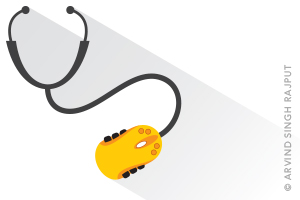
Fam Pract Manag. 2018;25(4):32
USE A VIDEO GAME MOUSE TO “BEAT” YOUR EHR

Primary care teams who use electronic health records (EHRs) often complain that common tasks require selecting from complex menus or entering multiple keystrokes, which slows them down and causes frustration. One method we have found helpful is using higher end computer mice that are popular with online video game players. These typically have numerous additional buttons, which can be programmed to enter combinations of keystrokes, commands, or blocks of text. It is a good idea to program the mice in a standardized way so that users can move from one computer to another without losing any capability and those who don’t like having extra buttons can still use the mice in conventional ways.
BUILD A BETTER MEETING
One of the reasons people don’t like meetings is because they often aren’t well planned. To make your meetings more efficient and effective, follow these guidelines:
Make sure the meeting is the best or only way to move forward on an issue.
Assign responsibility for the meeting to a single person (even if that is you).
Invite only people who truly need to be at the meeting, and make sure no vital people are missing from the invite list.
Avoid getting bogged down if someone doesn’t attend; ensure the group can take action or make a decision without that person.
Make all information relevant to the meeting discussion available to attendees well ahead of time.
Meet only as long as is necessary to reach the meeting’s goal. At the outset of the meeting, clearly state the goal and explain that once the group makes the key decision, the meeting will end.
PLAN YOUR HUDDLES
Many care teams have embraced huddles as a way to plan for the day’s schedule and improve efficiency. Using an “agenda” to guide huddles helps keep them focused and brief. The care teams at our residency site refer to a “huddle sheet” that includes these items:
Gather for huddle. (10 seconds)
Review availability of providers, nursing staff, and front desk/reception staff. (20 seconds)
Review availability of behavioral health care. (20 seconds)
Review appointment schedules to discuss potential issues or opportunities. (60 seconds)
Review opportunities for double booking. (30 seconds)
Identify special needs (e.g., a patient needing a larger exam room). (30 seconds)
Make other announcements/reminders. (30 seconds)
Review educational opportunities. (30 seconds)
Share kudos/review upcoming team events. (20 seconds)
Review prior day — what went well, and what do we need to work on? (30 seconds)
Review metrics — phone stats, visit volume, and patient feedback. (30 seconds)
Announce new team members. (10 seconds)
IMPROVE YOUR EHR SPEED
Using an electronic health record can be time-consuming, especially if you are a slow typist. Here are three steps you can take to work faster:
Use semicolons and paragraph returns to build separate phrases instead of writing full sentences.
Commit to 10 minutes a day of typing practice using sites such as https://www.typing.com/ or https://www.typingclub.com/.
Create templates for common conditions or treatments — or use templates developed by colleagues (see https://stressremedy.com/resources-for-primary-care-providers/).
